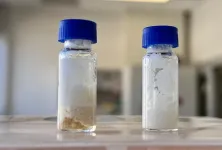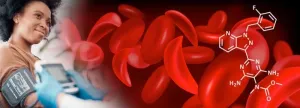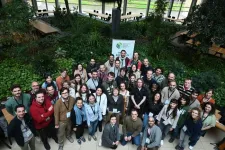(Press-News.org) Adding one simple rule to an idealized game of billiards leads to a wealth of intriguing mathematical questions, as well as applications in the physics of living organisms. This week, researchers from the University of Amsterdam, including two master students as first authors – have published a paper in Physical Review Letters about the fascinating dynamics of billiards with memory.
Billiards: a mathematical mystery
An idealized version of the game of billiards has fascinated mathematicians for decades. The basic question is a simple one: once a billiard ball is played, where does it go and where does it end up? Assume that the billiard is perfect: the walls are perfectly bouncy, there are no other objects on the table, the motion of the ball is frictionless, and so on. Then the ball will not really ‘end’ anywhere: it will keep going forever. But does it ever return where it started? Does it eventually visit every part of the table? When we slightly change the direction of the ball, or its starting location, does the path it follows look like the previous one?
All of these questions turn out to be very intriguing from a mathematical point of view. Their answers are not always known – especially when the shape of the billiard is not simple, like a square or a rectangle. For example, on triangular billiards with corners of less than 100 degrees, it is known that there are always periodic paths – paths that the ball can follow and that return on themselves. This can be proven mathematically. Now, change one of the corners to a slightly bigger angle, and no mathematician knows the answer anymore.
Idealized games of billiards are not just a favorite pastime of mathematicians. They also have a profound impact on physics and other sciences. Many of the questions about billiards can be phrased as questions about chaos: do similar initial conditions of a dynamical system – whether it is a ball on a billiard table, a molecule in a gas or a bird in a flock – always lead to similar final results?
A new rule
In research carried out at the University of Amsterdam, a team of physicists have realized that by slightly changing the rules of the billiards game, the number of applications in the real world increases even further. Mazi Jalaal, co-author of the publication and head of the group in which the research was done, explains: “In nature, many living organisms have an external form of memory. For example, they leave traces to remember where they have been. They can then use that information to either follow the same route again, or – say, when searching for food – to not explore that same region again.”
The latter option led the researchers to an interesting idea: what if we add one rule to the billiards game, namely that the ball may never cross its own previous path? The result – see the figure below – is that the effective size of the billiard table gets smaller and smaller. In fact, the ball eventually gets trapped by its own trajectory.
Intriguing new questions
The trapping effect makes the system even more intriguing. Even simple questions now become extremely fascinating. How far does a ball travel before it gets trapped? The answer varies, both on the shape of the table and on the starting point and direction of the ball. Sometimes the ball travels a length that is only a few times the size of the table, sometimes it can go for 100 times that length before it gets trapped. Where the ball eventually ends up in its trapped state is also an intricate question: repeating the experiment on a computer millions of times, every time with a slightly different starting position and velocity, leads to beautiful patterns of final configurations.
The image at the top of this text shows some of these beautiful examples. Interestingly, the resulting dynamical systems can be chaotic. Changing the starting position or velocity of the self-avoiding ball only slightly can lead to it being trapped at a completely different point on the billiard. Additionally, contrary to what happens on an ordinary billiard table, the self-avoiding ball is not equally likely to end up just anywhere. Some regions are more likely than others. To explain and prove all of these features, the mathematicians certainly have their work cut out.
Endless applications
An interesting particularity of the publication is that both of its first authors are master students. Mazi Jalaal adds: “The idea of a ‘billiard with memory’ is simple enough and new enough that studying it does not require years of experience. Thijs and Stijn did a great job in making the material their own and finding clever ways to study all these new open problems. I am very happy that they can already be lead authors of a publication.”
The results are only the first steps in what could be an entire new area of research. Not only are there many interesting mathematical questions that are now waiting to be answered; the applications in physics, including biophysics, are also endless. Jalaal: “The concept of trapping is one that begs to be explored, also in real-life systems. For instance, we know that single-celled slime molds use self-avoiding paths. Do they also get trapped, and what happens when they do? Or do they have clever mechanisms to avoid this from happening at all? Do they use it to enhance search strategies for food? The results would help us to better understand these biological systems, and perhaps even incorporate the lessons we learn to optimize this form of billiards with memory for use in robots.”
Publication
Billiards with Spatial Memory, Thijs Albers, Stijn Delnoij, Nico Schramma and Maziyar Jalaal, Physical Review Letters.
END
Trapped in the middle: billiards with memory
2024-04-11
ELSE PRESS RELEASES FROM THIS DATE:
A new spin on organic shampoo makes it sudsier, longer lasting
2024-04-11
While there’s no regulation in the U.S. for what’s in organic shampoos, they tend to contain ingredients perceived as safe or environmentally friendly. However, these “clean” shampoos separate and spoil faster than those made with synthetic stabilizers and preservatives. Now, researchers in ACS Sustainable Chemistry & Engineering demonstrate that a simple process — spinning organic shampoo at high speeds — improved the final products’ shelf lives and ability to clean hair.
Natural emulsifiers, such as xanthan gum and cetyl alcohol, ...
Nanoscale movies shed light on one barrier to a clean energy future
2024-04-11
DURHAM, N.C. -- Left unchecked, corrosion can rust out cars and pipes, take down buildings and bridges, and eat away at our monuments.
Corrosion can also damage devices that could be key to a clean energy future. And now, Duke University researchers have captured extreme close-ups of that process in action.
“By studying how and why renewable energy devices break down over time, we might be able to extend their lifetime,” said chemistry professor and senior author Ivan Moreno-Hernandez.
In his lab at Duke sits a miniature version of one such device. Called an electrolyzer, ...
American College of Lifestyle Medicine announces first two medical schools to earn highest recognition and certification for lifestyle medicine curriculum
2024-04-11
The American College of Lifestyle Medicine (ACLM) has announced that the University of South Carolina School of Medicine Greenville (SOMG) and Loma Linda University School of Medicine (LLUSM) are the first to earn the highest recognition of a “Platinum Plus” certification designation for the significant level of undergraduate lifestyle medicine curricula within their programs.
The Platinum Plus is the highest tier of certification that a medical school can receive from ACLM and indicates the incorporation of at least 100 hours of evidence-based lifestyle medicine content within the curriculum. This level of lifestyle medicine ...
Avi Wigderson receives ACM A.M. Turing Award for groundbreaking insights on randomness
2024-04-11
ACM, the Association for Computing Machinery, today named Avi Wigderson as recipient of the 2023 ACM A.M. Turing Award for foundational contributions to the theory of computation, including reshaping our understanding of the role of randomness in computation, and for his decades of intellectual leadership in theoretical computer science.
Wigderson is the Herbert H. Maass Professor in the School of Mathematics at the Institute for Advanced Study in Princeton, New Jersey. He has been a leading figure in areas including computational complexity theory, algorithms and optimization, randomness and cryptography, parallel and distributed computation, combinatorics, and graph theory, as well as ...
NAWI awarded funding to continue to accelerate research and development for a secure water future
2024-04-11
– By Lauren Core
The National Alliance for Water Innovation (NAWI), which is led by the Department of Energy’s (DOE) Lawrence Berkeley National Laboratory (Berkeley Lab), has been extended for five more years with $75 million in funding from DOE. NAWI will continue its contributions to helping decarbonize the water and wastewater sectors through investments in technologies that enhance the efficient use of energy for water use, treatment, and distribution.
“Water and energy are interdependent – water is used to produce nearly every major energy source, and ...
2024 Research Fellowship Awards to support three exciting disease intervention research projects
2024-04-11
Systems Biology Ireland (SBI) at University College Dublin (UCD) and The Quantitative Biosciences Institute (QBI) at the University of California, San Francisco (UCSF), and) have announced the 2024 winners of the joint Research Fellowship Awards (RFAs).
The Research Fellowship Awards aim to support collaborative high quality and ground -breaking research proposals from QBI-UCSF and UCD in the areas of network biology and drug/drug target discovery.
The winning projects for 2024 are:
“Overcoming Resistance to HER2-Targeted Therapies in Breast Cancer,” ...
Laura Soucek receives an ERC Advanced Grant to maximize the clinical and preclinical use of the first viable MYC inhibitor
2024-04-11
Laura Soucek, an ICREA Research Professor, Director of VHIO’s Experimental Therapeutics Program, and Head of our Models of Cancer Therapies Group, has received a European Research Council (ERC) Advanced Grant to maximize the use of the first clinically viable MYC inhibitor.
This ERC funding program is amongst the EU’s most prestigious and competitive, providing leading senior researchers with the opportunity to pursue ambitious, curiosity-driven projects that could lead to major scientific breakthroughs. The new grants, worth in total nearly €652 million, are part of the EU’s Horizon Europe programme. ...
UMSOM researchers identify safety of a potential new treatment to manage complications from sickle cell disease
2024-04-11
A drug approved to treat pulmonary arterial hypertension may be effective at managing hypertension and end-organ damage in patients with sickle cell disease, according to a new study published in Lancet Haematology. An early phase randomized clinical trial involving 130 patients with sickle cell disease found that the drug, called riociguat, was found to be safe to use and well tolerated in these patients and significantly improved their blood pressure. Preliminary efficacy data suggested the medication might improve heart function.
An estimated 100,000 Americans ...
Advancing biodiversity data analysis at B-Cubed’s Hackathon
2024-04-11
B-Cubed’s Hackathon – “Hacking Biodiversity Data Cubes for Policy” – concluded successfully on 5 April in Brussels. The event marked a significant milestone in the use of data cubes for enhancing biodiversity data analysis and policy-making. Over four days, participants from diverse backgrounds collaborated to explore innovative solutions aimed at standardising and improving the accessibility of biodiversity data.
The event began with a foundational presentation on data cubes by Andrew Rodrigues ...
Hypertensive disorders of pregnancy increase risk of cardiovascular death after giving birth
2024-04-11
Rutgers Health researchers have found that hypertensive disorders in pregnancy are strongly associated with fatal cardiovascular disease for up to a year after birth.
Among the hypertensive disorders that cause dangerously high blood pressure during pregnancy — chronic hypertension, gestational hypertension, preeclampsia without severe features, preeclampsia with severe features, superimposed preeclampsia and eclampsia — all but gestational diabetes were associated with a doubling in the risk of fatal cardiovascular disease compared to women with normal blood pressure.
Eclampsia, a condition whereby hypertensive ...






